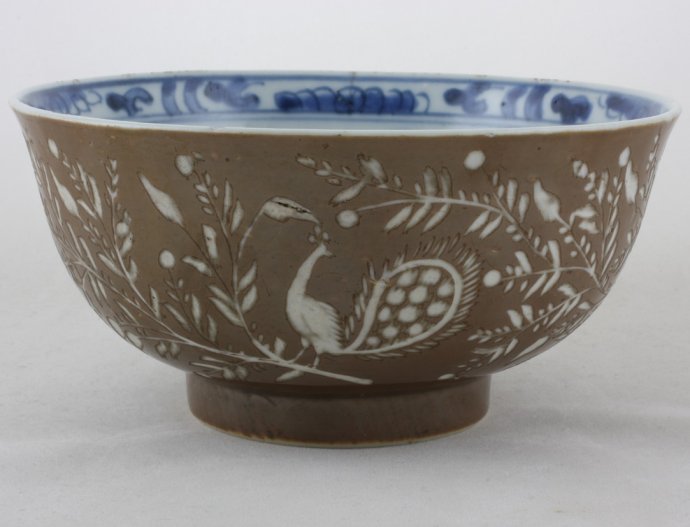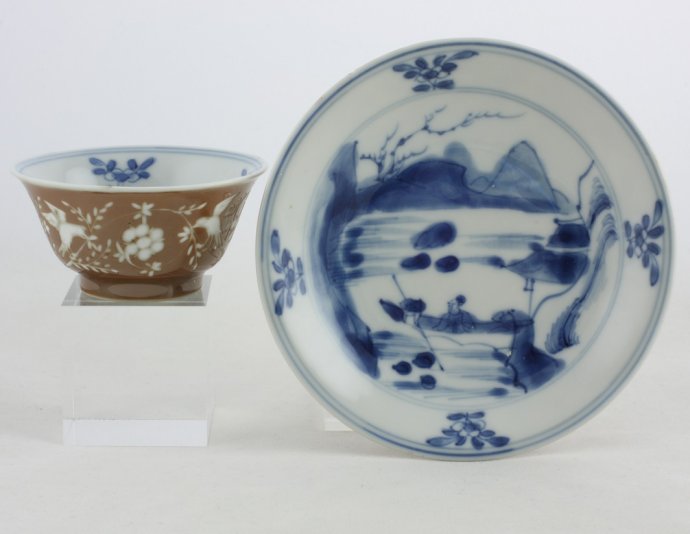Sold Ceramics
Sold Batavia Brown (Capucin wares) 1700-1800
Wheel engraved
Page 1
In the Netherlands, porcelain decorated in this type of underglaze brown has historically been called "Batavia Brown" or "Capucijnergoed" ("Chick-pea ware", after the legume). The first name may have been coined because most goods exported to The Netherlands from the East were sent via Batavia and has nothing to do with a Batavian production or decoration, It is a very common type with the decoration usually contained within medallions. Occasionally, a gold decoration has been painted on the brown glaze. The brown colour is achieved by using iron oxide as a pigment, which like underglaze blue, needs to be fired at high temperatures. Considerable quantities were exported to the Western and Inter-Asian markets from c.1700. The pieces are rarely refined and can be considered as articles for everyday use by the middle-classes. (Jörg 2002/2, p.120)
Wheel engraving cuts through the glaze, using copper wheels of varying sizes and abrasives, and reveals the porcelain´s white body. This European technique was first developed for glass around 1590 to 1605, and then applied to ceramics. Commentators have speculated that this demonstrably European carved decoration may have been performed by either Bohemian, Saxon or Silesian craftsmen. The former collection of King Augustus the Strong in Dresden contains several wheel engraved sets. An inventory drawn up in the period 1721-1727 notes that the Saxon Minister Count Vitzthum had several items brought from Holland in December 1723 at the King's command, suggesting that the engraving was carried out there. Given the predominance of Bohemian glass traders and artist in Amsterdam and many other European cities at the time, this was probably their work. (Sargent 2012, p.504), (Emden 2015/1, p.124)

Sold Ceramics - Sold Batavia Brown (Capucin wares) 1700-1800 - Wheel engraved - Page 1
Object 2012502
Bowl
China
1740-1760
Height 77 mm (3.03 inch), diameter of rim 154 mm (6.06 inch), diameter of footring 66 mm (2.60 inch), weight 318 grams (11.22 ounce (oz.))
Bowl on footring with steeply rounded sides flaring towards a slightly everted rim. The outside is covered with so-called Batavia-Brown, underglaze dark brown. Decorated in underglaze blue on the bottom with peony and chrysanthemum plants growing from rockwork in a double concentric band. On the sides wide spread peony and chrysanthemum flower sprays flanked by a single flowering stem. Around the rim reserves filled with half flower heads. On the outside wheel engraved decoration with a peacock, a bird and a lantern amongst two wide spread floral sprays. Marked on the base with the symbol mark: 'Pair of fish', (shuang yu) one of the eight Buddhist Emblems and symbol of marital bliss, in a double circle in underglaze blue. (Davison 1994, cat. 1825)
In the Netherlands, porcelain decorated in this type of underglaze brown has historically been called "Batavia Brown" or "Capucijnergoed" ("Chick-pea ware", after the legume). The first name may have been coined because most goods exported to The Netherlands from the East were sent via Batavia and has nothing to do with a Batavian production or decoration, It is a very common type with the decoration usually contained within medallions. Occasionally, a gold decoration has been painted on the brown glaze. The brown colour is achieved by using iron oxide as a pigment, which like underglaze blue, needs to be fired at high temperatures. Considerable quantities were exported to the Western and Inter-Asian markets from c.1700. The pieces are rarely refined and can be considered as articles for everyday use by the middle-classes. (Jörg 2002/2, p.120)
Wheel engraving cuts through the glaze, using copper wheels of varying sizes and abrasives, and reveals the porcelain´s white body. This European technique was first developed for glass around 1590 to 1605, and then applied to ceramics. Commentators have speculated that this demonstrably European carved decoration may have been performed by either Bohemian, Saxon or Silesian craftsmen. The former collection of King Augustus the Strong in Dresden contains several wheel engraved sets. An inventory drawn up in the period 1721-1727 notes that the Saxon Minister Count Vitzthum had several items brought from Holland in December 1723 at the King's command, suggesting that the engraving was carried out there. Given the predominance of Bohemian glass traders and artist in Amsterdam and many other European cities at the time, this was probably their work. (Sargent 2012, p.504), (Emden 2015/1, p.124)
For other, earlier sold, wheel engraved objects, please see:
Condition: Two firing flaws to the footring and some glaze rough spots, fleabites and a frit to the rim.
References:
Price: Sold.

Sold Ceramics - Sold Batavia Brown (Capucin wares) 1700-1800 - Wheel engraved - Page 1
Object 2011784
Teacup and saucer
China
1720-1730
Height of teacup 35 mm (1.38 inch), diameter of rim 70 mm (2.76 inch), diameter of footring 31 mm (1.22 inch), weight 35 grams (1.23 ounce (oz.))
Height of saucer 20 mm (0.79 inch), diameter of rim 113 mm (4.45 inch), diameter of footring 61 mm (2.40 inch), weight 65 grams (2.29 ounce (oz.))
Teacup and saucer on footrings, slightly everted rims. Batavia Brown covered with underglaze dark brown and underglaze-blue with a riverscape in a double circle, on the sides and rim four flowering stems. On the reverse a continuous, wheel engraved, decoration of birds and flowering scrolls. Marked on the base with a square shop mark in a double circle, underglaze blue. The teacup is decorated en suite.
For similarly, wheel engraved, Batavia Brown wares, please see:
- Treasures of Chinese Export Ceramics from the Peabody Essex Museum, (W.R. Sargent, Salem, Massachusetts, 2012), p.504, plate 276.
- European Decoration on Oriental Porcelain 1700-1830, (H. Espir, Jorge Welsh Books, London, UK, 2005), p.59, cat 12.
-
Have a Cup of Tea. Chinese Porcelain and Tea in North-West Germany, (Exhibition catalogue, Isensee Verlag, Oldenburg, 2015), p.124, cat. 103 / Made in China, Porzellan und Teekultur im Nordwesten, (Exhibition catalogue, Isensee Verlag, Oldenburg, 2015), p.158, cat. 103.
- The Helen Espir Collection of European Decorated Oriental Porcelain, auction catalogue Woolley & Wallis Salisbury, 12 November 2014, p.56, cat. 391 & 392.
Condition:
Teacup: Three popped bubbles of glaze to the rim, caused by the firing process..
Saucer: A popped bubble of glaze to the rim caused by the firing process and some fleabites to the footring.
References:
Lunsingh Scheurleer 1989, p.133
Sargent 2012, p. 505, plate 276
Salisbury 2014, cat. 391 & 392
Price: Sold.
More pictures of object 2011582, another similarly shaped, sized and decorated, sold saucer >>

Sold Ceramics - Sold Batavia Brown (Capucin wares) 1700-1800 - Wheel engraved - Page 1
Object 2012053
Teacup and saucer
China
1720-1730
Height of teacup 40 mm (1.57 inch), diameter of rim 69 mm (2.72 inch), diameter of footring 33 mm (1.30 inch), weight 44 grams (1.55 ounce (oz.))
Height of saucer 24 mm (0.94 inch), diameter of rim 110 mm (4.33 inch), diameter of footring 55 mm (2.17 inch), weight 65 grams (2.29 ounce (oz.))
Teacup and saucer on footrings, slightly everted rims. Batavia Brown covered with underglaze dark brown. Wheel engraved decorated with floral designs and knotted garlands. The teacup is decorated en suite.
For similarly, wheel engraved, Batavia Brown wares, please see:
-
Sold Ceramics - Sold Batavia Brown (Capucin wares) 1700-1800 - Object 2011784.
-
Sold Ceramics - Sold Batavia Brown (Capucin wares) 1700-1800 - Object 2011582.
- Treasures of Chinese Export Ceramics from the Peabody Essex Museum, (W.R. Sargent, Salem, Massachusetts, 2012), p.504, plate 276.
- European Decoration on Oriental Porcelain 1700-1830, (H. Espir, Jorge Welsh Books, London, UK, 2005), p.59, cat 12.
-
Have a Cup of Tea. Chinese Porcelain and Tea in North-West Germany, (Exhibition catalogue, Isensee Verlag, Oldenburg, 2015), p.124, cat. 103 / Made in China, Porzellan und Teekultur im Nordwesten, (Exhibition catalogue, Isensee Verlag, Oldenburg, 2015), p.158, cat. 103.
- The Helen Espir Collection of European Decorated Oriental Porcelain, auction catalogue Woolley & Wallis Salisbury, 12 November 2014, p.56, cat. 391 & 392.
- Asian Ceramics in The Hallwyl Collection, (R. Kerr, The Hallwyl Museum, Stockholm, 2015), pp.112-113, cat. 106.
Condition:
Teacup: A firing flaw to the inner footring and a fleabite and frit to the rim.
Saucer: Some firing flaws to the base.
References:
Lunsingh Scheurleer 1989, p.133
Sargent 2012, p. 505, plate 276
Salisbury 2014, cat. 391 & 392
Price: Sold.


 create websites
create websites